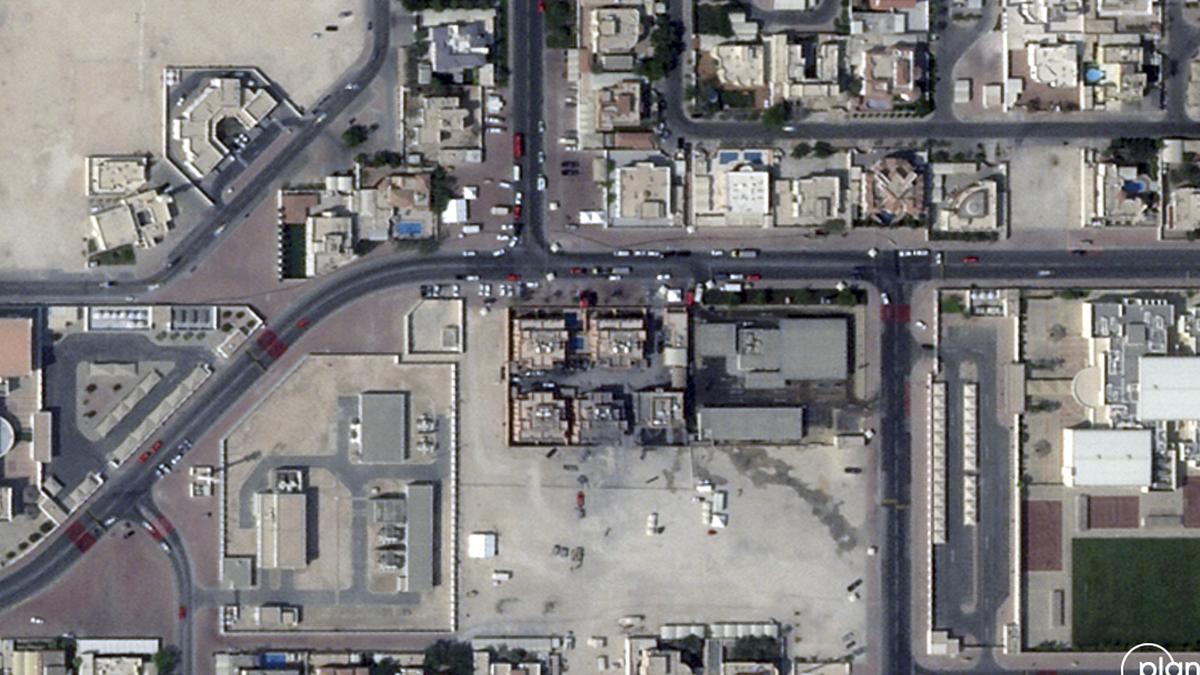US President Donald Trump has authorized Tony Blair to rally regional and international stakeholders around the former UK prime minister’s proposal to establish a postwar transitional body to govern the Gaza Strip until it can be handed over to the Palestinian Authority, four sources familiar with the matter told The Times of Israel.
Blair began crafting the proposal in the early months of the war between Israel and the Hamas terror group, envisioning it as a plan for the so-called “day after.” But in recent months, the proposal has also evolved into a plan for effectively ending the war, as the Trump administration has reached the conclusion that agreement from major stakeholders regarding the body that will replace Hamas in Gaza is essential for securing a permanent ceasefire and hostage release deal, a US official and a second source familiar with the matter said.
While Blair’s involvement in postwar Gaza planning has been previously revealed, along with his participation in an August 27 White House policy session on the matter, details of his proposal have not been publicized to date.
Not a displacement plan
The proposal — a developed draft of which was obtained and authenticated by The Times of Israel — envisions the establishment of the Gaza International Transitional Authority (GITA) along with a series of subordinate structures.
Previous reporting has linked Blair to efforts aimed at displacing Palestinians from Gaza or at building a “Trump Riviera” in the Strip, but the former British premier’s actual proposal makes no mention of those ideas and even envisions the establishment of a “Property Rights Preservation Unit,” aimed at ensuring that any voluntary departure of Gazans does not compromise their right to return to the enclave or retain property ownership.
Get The Times of Israel’s Daily Edition
by email and never miss our top stories
By signing up, you agree to the terms
“We do not have a plan to move the Gazan population out of Gaza. Gaza is for Gazans,” said a source involved in discussions on the Blair plan.
Displaced Palestinians move with their belongings southwards on a road in the Nuseirat refugee camp area in the central Gaza Strip following renewed Israeli evacuation orders for Gaza City on September 16, 2025. (Eyad BABA / AFP)
Other plans presented to the Trump administration by parties with ties to Prime Minister Benjamin Netanyahu’s confidant Strategic Affairs Minister Ron Dermer, and by certain individuals involved in the establishment of the Gaza Humanitarian Foundation (GHF) as well as members of the Boston Consulting Group (BCG), did promote the idea of facilitating or encouraging the “voluntary migration” of Palestinians from Gaza.
But Trump — who first gave legitimacy to the concept of “voluntary migration” in February when he announced his plan to take over Gaza and permanently relocate the Strip’s entire population — has since distanced himself from the idea, and during the August 27 White House policy session made clear that he was going with Blair’s plan instead, the US official said.
The US official noted that Finance Minister Bezalel Smotrich is apparently unaware of that decision, having declared on Wednesday that the Gaza Strip is a potential real estate “bonanza” and that he was in talks with Washington on how to carve up the coastal enclave after the war.
The Kushner connection
The August 27 meeting was organized by the US president’s son-in-law Jared Kushner, who served as senior adviser during Trump’s first term and has remained engaged on Middle East issues during his second term, regularly advising US special envoy Steve Witkoff.
Like Kushner in his time, Witkoff has been handed a variety of portfolios. The current special envoy has hired limited support staff, though, and Kushner has been helping with the Gaza day-after planning, as it is increasingly seen as critical for securing a war-ending hostage release deal.

White House special envoy Steve Witkoff, right, and Jared Kushner wait for the arrival of US President Donald Trump at Teterboro Airport in Teterboro, N.J. on July 13, 2025. (AP Photo/Jacquelyn Martin)
This spring, Kushner commissioned the Tony Blair Institute for Global Change (TBI) — which was already engaged on the issue thanks to the former UK prime minister’s ties with Israeli, PA and Arab leaders — to come up with a postwar plan, the US official said.
Blair began regular engagement with Trump officials, keeping them abreast of his progress as he met with leaders throughout the region and began ironing out details of his plan, the source familiar with discussions said.
Not enough PA involvement for Ramallah, but too much for Jerusalem
The former UK premier met PA President Mahmoud Abbas in July, thanks to Gulf pressure on Ramallah to engage with the initiative, an Arab diplomat said.
While the PA has expressed its desire to directly oversee the postwar governing body in Gaza and Blair’s plan falls short of that goal, the source familiar with the discussions said Ramallah has “engaged constructively.”
Blair’s proposal envisions the PA undergoing significant reforms and limits Ramallah’s involvement in GITA largely to matters of coordination. Still, the PA is explicitly mentioned throughout the plan, which envisions “the eventual unifying of all the Palestinian territory under the PA.”

This handout picture released by the Palestinian Authority’s press office (PPO) shows President Mahmoud Abbas (R) meeting with Britain’s former prime minister Tony Blair in Amman, Jordan, on July 13, 2025. (Thaer GHANAIM / PPO / AFP)
Though that is a development Netanyahu has fought fiercely to prevent, the source familiar with discussions said that Israel has engaged constructively with Blair’s effort.
The Arab diplomat expressed a little more skepticism, however, claiming that Netanyahu has a history of dispatching Dermer to engage on such sensitive matters, then thwarting them before they can materialize in order to keep his coalition, including its far-right flank, intact.
Doha strike derails effort to get ‘Johnny’ on board
Still, Trump was impressed by Blair’s initiative and told him to get “Johnny” on board, the US official said, recalling the moniker Trump used to refer to Saudi Crown Prince Mohammed bin Salman during the August 27 White House meeting.
The US views Saudi Arabia as one of the most critical players when it comes to postwar reconstruction, with enough sway to get the rest of the region on board.
While Trump gave Blair his blessing, he also gave him a two-week window to secure regional support for the plan, the US official said.
That deadline has since expired, but the time period was one the president has announced somewhat regularly without sticking to it.

US President Donald Trump (right) arrives with Saudi Crown Prince Mohammed bin Salman for the group photo with Gulf Cooperation Council leaders during the GCC Summit in Riyadh, Saudi Arabia, May 14, 2025. (Alex Brandon/AP)
During that period, Blair was also hobbled by the US issuing visa bans against senior PA officials. That decision led to delays in some of the British premier’s meetings with Gulf officials who didn’t want to be seen as endorsing the administration’s decision by immediately meeting with an effective Trump envoy right afterward, the Arab diplomat said.
Still more damaging to Blair’s effort was Israel’s September 9 strike against Hamas leaders in Doha, the source familiar with discussions said.
The former British premier had been engaging Egypt and Qatar about coaxing the terror group not to stand in the way of the plan, the source said, adding that while Blair’s effort was temporarily derailed by the Israeli strike, engagement has since resumed.
‘We don’t have weeks. We have days’
The Doha strike also highlighted what may be one of the main obstacles Blair faces in trying to sell his plan to Israel.
While Netanyahu says the strike was aimed at sending a message to Hamas’s leadership — even those involved in hostage negotiations — conveying that Israel will settle scores with all of them, an apparent goal of Blair’s plan is to neutralize the terror group through nonmilitary means.
Alongside establishing an alternative to Hamas through GITA, the plan also explicitly refers to the concept of “disarmament, demobilization, and reintegration” or DDR.

This grab from video footage released by Qatar TV shows men carrying the flag-draped bodies of six people killed in an Israeli strike on Hamas figures two days earlier, inside the Sheikh Mohammed bin Abdul Wahhab Mosque in Doha on September 11, 2025. (QATAR TV / AFP)
US Secretary of State Marco Rubio may have been referring to that very idea when he said during a press conference with Netanyahu in Jerusalem that “Hamas can no longer continue to exist as an armed element,” as opposed to asserting that the terror group should not exist at all, which has been the Israeli prime minister’s framing.
In the meantime, the Arab diplomat said that Blair also faces an uphill battle getting Riyadh and other regional stakeholders on board, as they are conditioning their support on the plan containing the creation of an irreversible pathway to a future Palestinian state — an idea long abhorred by Netanyahu and his far-right coalition partners.
The aforementioned pathway is one of a list of principles that Arab stakeholders are demanding be folded into any plan they’re being asked to bankroll, the Arab diplomat said.
Still, the source involved in discussions said that Blair has made inroads with regional stakeholders and is racing to advance his plan within a short time frame.
“We don’t have months or weeks. We have days,” the source said.
What’s in the plan
Blair’s proposal envisions GITA being established by a UN Security Council resolution.
GITA will serve as the “supreme political and legal authority for Gaza during the transitional period,” the developed draft of the plan obtained by The Times of Israel states.
GITA will have a board made up of seven to 10 members, which will include “at least one qualified Palestinian representative (potentially from the business or security sector),” a senior UN official, leading international figures with executive or financial experience, and a “strong representation of Muslim members” to boost regional legitimacy and cultural credibility.

An organizational chart featured in former UK prime minister Tony Blair’s plan to establish a Gaza International Transitional Authority that was obtained by The Times of Israel in September 2025.
The board will be tasked with “issu[ing] binding decisions, approv[ing] legislation and appointments and provid[ing] strategic direction,” while reporting back to the UN Security Council.
The chair of the board will be appointed by international consensus and receive the endorsement of the UN Security Council. The chair will lead GITA’s external engagement and diplomacy and set the political direction of the body while closely coordinating with the PA, the document says.
The GITA board chair will have a supporting staff of up to 25 people who will serve on the “strategic secretariat.”
The plan also envisions the creation of an Executive Protection Unit “staffed by elite personnel from Arab and international contributors” to protect the GITA leadership.
An “Executive Secretariat” will sit below GITA and serve as the latter’s administrative hub and implementation arm, while directly overseeing the Palestinian Executive Authority (PEA).
The latter body is what has often been referred to as the committee of independent Palestinian technocrats who will be responsible for administering Gaza after the war.

IDF troops operate in Gaza City, in a handout photo issued on September 17, 2025. (Israel Defense Forces)
PA coordination
Reporting to the Executive Secretariat will be a group of five commissioners who will supervise key areas of Gaza governance: humanitarian affairs, reconstruction, legislation and legal affairs, security, and PA coordination.
Notably, the plan states that the commissioner overseeing humanitarian affairs will be responsible for coordinating with humanitarian agencies, including the Gaza Humanitarian Foundation, which some Arab stakeholders have been demanding be dismantled.
As for the PA coordination commissioner, the plan envisions the aim of their office being to “ensure that the decisions of GITA and those of the PA are, so far as possible, aligned and consistent with the eventual unifying of all the Palestinian territory under the PA.”
The commissioner will also “track PA reform efforts in coordination with international donors, financial institutions and Arab partners engaged in Palestinian institutional development.”
The source involved in the discussions stressed that the reforms that the Blair plan expects of the PA “are not cosmetic,” and that part of the reason there’s not a set timeline for GITA to hand over authority of Gaza to the PA is that the process is “performance-based.”

Demonstrators protest against Gaza City operation outside the Jerusalem Post conference in Jerusalem, call for the release of hostages held in the Gaza Strip, September 16, 2025. (Yonatan Sindel/Flash90)
Still, the source clarified that the timeline will be several years, “not ten.”
The plan envisions the establishment of the Gaza Investment Promotion and Economic Development Authority to secure investments for GITA and Gaza’s reconstruction. It will be a “commercially driven authority, led by business professionals and tasked with generating investable projects with real financial returns.”
A separate body will be established to secure and distribute government grants.
Also reporting to GITA and its Executive Secretariat will be the Palestinian Executive Authority, which will interface more directly with Palestinians by delivering services “through a nonpartisan, professional administration.”
The PEA will be headed by a CEO formally appointed by the GITA board and will be responsible for overseeing a series of technocratic ministries, including health, education, finance, infrastructure, judicial affairs and welfare.
Also reporting to the PEA will be Gaza municipalities, which will be responsible for delivering services at the local level; a Gaza civil police force of “nationally recruited, professionally vetted, and nonpartisan” officers tasked with maintaining public order and protecting civilians; a judicial board chaired by an Arab jurist who will supervise Gaza’s courts and public prosecution office; and the aforementioned “Property Rights Preservation Unit.”
Preventing Hamas’s resurgence
Backing the civil police force will be the “International Stabilization Force (ISF) — an internationally mandated, multinational security force established to provide strategic stability and operational protection in Gaza during the transitional period.”
“It ensures border integrity, deters armed group resurgence, protects humanitarian and reconstruction operations, and supports local law enforcement through coordination — not substitution,” the plan states.

US President Donald Trump hosts families of hostages held by Hamas in Gaza, at the White House on September 10, 2025. (Hostages Families Forum)
In an apparent reference to its task of combating remnants of Hamas, the plan says the ISF will “conduct targeted operations to prevent the resurgence of armed groups, disrupt weapons smuggling and neutralize asymmetric threats to public order and institutional functions.”
In an annex on GITA’s costs, the plan explains that the budget will expand each year as the new governing body gradually phases into operations throughout the entire Strip.
The first year’s budget is placed at $90 million, the second year at $135 million and the third year at $164 million. The figures don’t include the costs of the ISF and humanitarian aid, though, and the source familiar with the discussions said the estimates were conservative.
How to end the war
While Blair’s isn’t the only plan for the postwar management of Gaza, it appears to be the lone proposal that has secured US backing. Still, the source involved in the discussions acknowledged that it can’t be considered a US plan until Trump publicly says so.
The document has also gone through a few rounds of edits since it was obtained by The Times of Israel, as Blair continues to receive feedback from stakeholders, the source said.

The Mhanna tower collapses amid heavy smoke, after an Israeli strike following an evacuation order in the Tal el-Hawa neighborhood of Gaza City on September 14, 2025 (Omar AL-QATTAA / AFP)
“The way to end the war is to [get regional stakeholders to] agree on principles for how Gaza will be governed afterward in a manner that Hamas is not involved and not armed and unable to regain power,” the source said.
“This can only happen if there is a new governing structure in Gaza with a serious security force from the international community. This cannot be the PA in the beginning. The PA will be a partner. They’ll be consulted and coordinated with, but they won’t be the ones managing Gaza on day one. This will happen later on after they reform,” the source added.
Blair’s office declined to comment on the record for this story.
















